How Much Do Emotional, Behavioral, and Cognitive Factors Actually Impact College Student Attitudes towards English Language Learning? A Quantitative and Qualitative Study
Abstract
1. Introduction
- (1)
- Is there a significant difference among the students’ attitudes towards English learning in terms of major?
- (2)
- Which factors may have positive/negative impact on students’ attitudes and how do these factors directly or indirectly work?
2. Material and Methods
2.1. Design
2.2. Procedure for Data Collection
2.3. Demographical Information of the Participants
2.4. Statistical Method
| Algorithm 1 TAN. |
|
3. Results
3.1. Statistical Analysis for All Students and Discussion
3.2. Statistical Analysis for L-Students and Discussion
3.3. Statistical Analysis for S-Students and Discussion
4. Conclusions
Author Contributions
Funding
Conflicts of Interest
Appendix A
| No. | Q1 | Q2 | Q4 | Q5 | Q6 | Q7 | Q8 | Q9 | Q10 | Q11 | Q12 | Attitude |
|---|---|---|---|---|---|---|---|---|---|---|---|---|
| 1 | 3 | M | 2 | 1 | 1 | 1 | 3 | 2 | 2 | 1 | 1 | O |
| 2 | 3 | F | 1 | 1 | 1 | 1 | 3 | 1 | 2 | 1 | 1 | N |
| 3 | 4 | F | 1 | 1 | 1 | 1 | 3 | 1 | 2 | 1 | 1 | N |
| 4 | 3 | M | 1 | 2 | 2 | 2 | 2 | 2 | 2 | 2 | 2 | N |
| 5 | 2 | M | 2 | 1 | 2 | 2 | 3 | 1 | 2 | 1 | 2 | P |
| 6 | 1 | M | 1 | 1 | 2 | 2 | 3 | 2 | 2 | 1 | 3 | P |
| 7 | 2 | M | 2 | 1 | 2 | 2 | 2 | 1 | 2 | 2 | 2 | O |
| 8 | 1 | F | 2 | 1 | 3 | 3 | 2 | 1 | 2 | 1 | 2 | P |
| 9 | 2 | F | 2 | 2 | 2 | 2 | 3 | 2 | 3 | 1 | 3 | P |
| 10 | 2 | F | 1 | 1 | 1 | 1 | 2 | 1 | 1 | 2 | 1 | N |
| 11 | 1 | F | 2 | 1 | 2 | 2 | 2 | 1 | 2 | 1 | 3 | P |
| 12 | 2 | F | 2 | 2 | 3 | 2 | 3 | 2 | 3 | 1 | 3 | P |
| 13 | 4 | F | 2 | 1 | 2 | 1 | 2 | 2 | 2 | 1 | 1 | N |
| 14 | 2 | F | 1 | 1 | 1 | 1 | 3 | 1 | 1 | 1 | 1 | P |
| 15 | 4 | F | 1 | 1 | 1 | 1 | 3 | 1 | 2 | 1 | 1 | N |
| 16 | 4 | F | 1 | 2 | 2 | 2 | 2 | 2 | 2 | 2 | 2 | N |
| 17 | 2 | F | 1 | 2 | 2 | 2 | 3 | 2 | 2 | 1 | 1 | P |
| 18 | 2 | F | 2 | 1 | 2 | 2 | 2 | 1 | 3 | 1 | 1 | P |
| 19 | 3 | F | 2 | 2 | 2 | 2 | 3 | 3 | 3 | 1 | 1 | O |
| 20 | 3 | M | 1 | 1 | 1 | 1 | 2 | 1 | 2 | 1 | 1 | N |
| 21 | 3 | M | 2 | 1 | 2 | 2 | 2 | 1 | 2 | 1 | 1 | N |
| 22 | 3 | F | 2 | 2 | 3 | 3 | 3 | 2 | 3 | 1 | 3 | O |
| 23 | 3 | F | 2 | 1 | 2 | 2 | 3 | 2 | 1 | 2 | 2 | N |
| 24 | 3 | M | 1 | 1 | 1 | 1 | 3 | 1 | 2 | 2 | 2 | N |
| 25 | 3 | F | 1 | 1 | 1 | 1 | 3 | 1 | 2 | 1 | 1 | N |
| 26 | 4 | F | 1 | 2 | 2 | 2 | 2 | 1 | 2 | 1 | 1 | N |
| 27 | 2 | F | 2 | 1 | 2 | 2 | 2 | 1 | 2 | 1 | 1 | O |
| 28 | 4 | F | 2 | 1 | 2 | 2 | 2 | 2 | 2 | 1 | 3 | N |
| 29 | 4 | F | 2 | 1 | 2 | 2 | 2 | 1 | 2 | 1 | 1 | O |
| 30 | 2 | F | 2 | 1 | 2 | 2 | 2 | 1 | 2 | 2 | 2 | P |
| 31 | 2 | F | 2 | 2 | 2 | 2 | 1 | 2 | 3 | 2 | 2 | P |
| 32 | 3 | F | 1 | 1 | 1 | 1 | 2 | 1 | 1 | 2 | 1 | N |
| 33 | 3 | M | 2 | 1 | 2 | 2 | 2 | 1 | 2 | 1 | 1 | P |
| 34 | 3 | M | 2 | 2 | 2 | 3 | 1 | 2 | 3 | 1 | 3 | N |
| 35 | 3 | F | 1 | 1 | 1 | 1 | 2 | 1 | 1 | 1 | 1 | N |
| 36 | 3 | F | 2 | 1 | 2 | 2 | 2 | 1 | 2 | 1 | 1 | N |
| 37 | 3 | M | 1 | 2 | 3 | 2 | 1 | 2 | 3 | 1 | 1 | O |
| 38 | 3 | F | 2 | 1 | 2 | 2 | 1 | 2 | 2 | 2 | 2 | N |
| 39 | 2 | F | 1 | 1 | 1 | 1 | 3 | 1 | 1 | 2 | 2 | N |
| 40 | 3 | F | 2 | 1 | 1 | 1 | 3 | 1 | 2 | 1 | 1 | N |
| 41 | 2 | M | 1 | 2 | 2 | 2 | 2 | 2 | 2 | 1 | 1 | O |
| 42 | 3 | M | 2 | 1 | 2 | 2 | 1 | 1 | 2 | 1 | 1 | O |
| 43 | 2 | F | 1 | 1 | 2 | 2 | 1 | 2 | 2 | 1 | 1 | P |
| 44 | 3 | M | 2 | 1 | 2 | 2 | 2 | 1 | 2 | 1 | 3 | O |
| 45 | 2 | F | 1 | 2 | 2 | 2 | 2 | 1 | 2 | 1 | 1 | O |
| 46 | 3 | M | 2 | 1 | 2 | 2 | 2 | 1 | 2 | 1 | 1 | O |
| 47 | 2 | F | 2 | 1 | 2 | 2 | 2 | 2 | 2 | 1 | 3 | P |
| 48 | 4 | F | 2 | 1 | 2 | 2 | 2 | 1 | 2 | 1 | 1 | N |
| 49 | 4 | F | 2 | 1 | 2 | 2 | 2 | 1 | 2 | 2 | 2 | N |
| 50 | 2 | M | 2 | 2 | 2 | 2 | 1 | 2 | 3 | 2 | 2 | P |
| 51 | 3 | F | 1 | 1 | 1 | 1 | 2 | 1 | 1 | 2 | 1 | O |
| 52 | 2 | F | 2 | 1 | 2 | 2 | 2 | 1 | 2 | 1 | 1 | P |
| 53 | 3 | F | 2 | 2 | 2 | 3 | 1 | 2 | 3 | 1 | 3 | N |
| 54 | 2 | M | 1 | 1 | 1 | 1 | 2 | 1 | 1 | 1 | 1 | P |
| 55 | 3 | M | 2 | 1 | 2 | 2 | 2 | 1 | 2 | 1 | 1 | O |
| 56 | 2 | F | 1 | 2 | 3 | 2 | 1 | 2 | 3 | 1 | 1 | P |
| 57 | 3 | M | 2 | 1 | 2 | 2 | 1 | 2 | 2 | 2 | 2 | N |
| 58 | 2 | F | 2 | 1 | 2 | 2 | 1 | 1 | 2 | 1 | 1 | O |
| 59 | 3 | M | 1 | 1 | 1 | 1 | 2 | 1 | 1 | 1 | 1 | N |
| 60 | 2 | F | 2 | 1 | 2 | 2 | 2 | 1 | 2 | 1 | 1 | P |
| 61 | 4 | F | 1 | 2 | 3 | 2 | 1 | 2 | 3 | 1 | 1 | O |
| 62 | 4 | F | 2 | 1 | 2 | 2 | 1 | 2 | 2 | 2 | 2 | N |
| 63 | 2 | M | 1 | 1 | 1 | 1 | 3 | 1 | 1 | 2 | 2 | P |
| 64 | 3 | F | 2 | 1 | 1 | 1 | 3 | 1 | 2 | 1 | 1 | N |
| No. | Q1 | Q2 | Q4 | Q5 | Q6 | Q7 | Q8 | Q9 | Q10 | Q11 | Q12 | Attitude |
|---|---|---|---|---|---|---|---|---|---|---|---|---|
| 1 | 1 | M | 2 | 1 | 3 | 2 | 1 | 1 | 1 | 3 | 3 | N |
| 2 | 1 | M | 1 | 1 | 1 | 1 | 3 | 1 | 1 | 3 | 3 | N |
| 3 | 1 | F | 2 | 1 | 2 | 1 | 2 | 1 | 2 | 3 | 3 | N |
| 4 | 3 | F | 3 | 2 | 2 | 2 | 1 | 3 | 3 | 3 | 1 | O |
| 5 | 1 | F | 2 | 1 | 3 | 3 | 1 | 3 | 3 | 1 | 3 | P |
| 6 | 2 | M | 2 | 2 | 2 | 1 | 1 | 2 | 3 | 1 | 3 | P |
| 7 | 1 | M | 1 | 1 | 1 | 1 | 2 | 1 | 1 | 3 | 2 | N |
| 8 | 1 | F | 2 | 1 | 2 | 2 | 2 | 1 | 2 | 1 | 3 | P |
| 9 | 4 | F | 3 | 2 | 3 | 3 | 1 | 3 | 3 | 1 | 3 | P |
| 10 | 1 | F | 2 | 1 | 2 | 2 | 1 | 2 | 1 | 3 | 3 | N |
| 11 | 3 | F | 1 | 1 | 1 | 1 | 3 | 1 | 1 | 3 | 3 | N |
| 12 | 1 | F | 1 | 1 | 2 | 2 | 2 | 2 | 2 | 2 | 2 | O |
| 13 | 5 | M | 2 | 1 | 2 | 2 | 1 | 2 | 2 | 2 | 2 | O |
| 14 | 4 | F | 2 | 2 | 2 | 2 | 2 | 2 | 2 | 2 | 2 | O |
| 15 | 1 | M | 1 | 1 | 1 | 1 | 2 | 2 | 2 | 2 | 2 | O |
| 16 | 2 | M | 2 | 1 | 1 | 1 | 2 | 2 | 2 | 1 | 3 | O |
| 17 | 1 | F | 1 | 1 | 3 | 2 | 1 | 2 | 3 | 3 | 1 | O |
| 18 | 3 | M | 2 | 1 | 2 | 2 | 1 | 1 | 3 | 3 | 1 | P |
| 19 | 4 | F | 3 | 2 | 2 | 2 | 1 | 3 | 3 | 1 | 3 | P |
| 20 | 1 | F | 1 | 2 | 2 | 2 | 2 | 2 | 2 | 2 | 2 | O |
| 21 | 2 | M | 2 | 1 | 3 | 3 | 2 | 3 | 3 | 2 | 2 | O |
| 22 | 1 | F | 1 | 1 | 3 | 3 | 1 | 3 | 3 | 1 | 3 | P |
| 23 | 4 | M | 2 | 2 | 2 | 2 | 2 | 2 | 2 | 2 | 2 | O |
| 24 | 1 | F | 2 | 2 | 2 | 2 | 2 | 2 | 2 | 2 | 2 | O |
| 25 | 4 | M | 2 | 1 | 2 | 1 | 1 | 1 | 2 | 2 | 2 | O |
| 26 | 2 | F | 2 | 1 | 2 | 2 | 1 | 1 | 2 | 2 | 3 | O |
| 27 | 3 | F | 3 | 2 | 2 | 2 | 1 | 3 | 3 | 1 | 3 | P |
| 28 | 1 | F | 1 | 2 | 2 | 2 | 2 | 2 | 2 | 2 | 2 | O |
| 29 | 4 | M | 2 | 1 | 2 | 2 | 1 | 2 | 2 | 2 | 2 | O |
| 30 | 1 | F | 2 | 2 | 2 | 2 | 2 | 2 | 2 | 2 | 2 | O |
| 31 | 2 | M | 2 | 1 | 1 | 1 | 2 | 2 | 2 | 1 | 3 | P |
| 32 | 2 | F | 1 | 1 | 3 | 2 | 1 | 2 | 3 | 3 | 1 | P |
| 33 | 1 | F | 1 | 1 | 3 | 3 | 1 | 3 | 3 | 1 | 3 | P |
| 34 | 3 | M | 2 | 2 | 2 | 2 | 2 | 2 | 2 | 2 | 2 | O |
| 35 | 1 | F | 2 | 2 | 2 | 2 | 2 | 2 | 2 | 2 | 2 | O |
| 36 | 4 | M | 1 | 1 | 1 | 1 | 3 | 1 | 1 | 3 | 3 | N |
| 37 | 3 | F | 1 | 1 | 1 | 1 | 3 | 1 | 2 | 3 | 3 | N |
| 38 | 3 | F | 2 | 1 | 2 | 1 | 3 | 1 | 1 | 3 | 3 | N |
| 39 | 1 | M | 1 | 1 | 1 | 1 | 3 | 1 | 2 | 3 | 3 | N |
| 40 | 3 | F | 2 | 2 | 2 | 2 | 2 | 1 | 2 | 3 | 3 | N |
| 41 | 2 | F | 2 | 1 | 2 | 2 | 1 | 2 | 2 | 2 | 1 | P |
| 42 | 4 | M | 2 | 2 | 2 | 2 | 2 | 2 | 2 | 2 | 2 | O |
| 43 | 2 | M | 1 | 1 | 1 | 1 | 3 | 1 | 1 | 3 | 3 | N |
| 44 | 2 | F | 1 | 2 | 2 | 2 | 2 | 2 | 2 | 2 | 2 | O |
| 45 | 2 | F | 2 | 1 | 3 | 3 | 2 | 3 | 3 | 2 | 2 | O |
| 46 | 3 | F | 2 | 1 | 2 | 1 | 1 | 1 | 2 | 2 | 2 | O |
| 47 | 2 | M | 2 | 1 | 2 | 2 | 1 | 1 | 2 | 2 | 3 | O |
| 48 | 3 | M | 3 | 2 | 2 | 2 | 1 | 3 | 3 | 1 | 3 | P |
| 49 | 2 | F | 1 | 1 | 1 | 1 | 2 | 1 | 1 | 3 | 2 | N |
| 50 | 3 | M | 2 | 1 | 2 | 2 | 2 | 1 | 2 | 1 | 3 | P |
| 51 | 2 | F | 3 | 2 | 3 | 3 | 1 | 3 | 3 | 1 | 3 | P |
| 52 | 3 | M | 2 | 1 | 2 | 2 | 1 | 2 | 1 | 3 | 3 | N |
| 53 | 2 | F | 1 | 1 | 1 | 1 | 3 | 1 | 1 | 3 | 3 | N |
| 54 | 4 | F | 1 | 1 | 1 | 1 | 3 | 1 | 1 | 3 | 3 | N |
| 55 | 4 | F | 1 | 2 | 2 | 2 | 2 | 2 | 2 | 2 | 2 | O |
| 56 | 2 | M | 2 | 1 | 2 | 2 | 1 | 1 | 2 | 2 | 3 | O |
| 57 | 3 | F | 3 | 2 | 2 | 2 | 1 | 3 | 3 | 1 | 3 | P |
| 58 | 2 | M | 2 | 1 | 2 | 2 | 1 | 1 | 3 | 1 | 3 | P |
| 59 | 4 | F | 3 | 2 | 2 | 2 | 1 | 3 | 3 | 1 | 3 | P |
| 60 | 2 | F | 1 | 1 | 1 | 1 | 2 | 1 | 1 | 3 | 2 | N |
| 61 | 4 | M | 2 | 1 | 2 | 2 | 2 | 1 | 2 | 2 | 2 | P |
| 62 | 2 | F | 2 | 2 | 3 | 3 | 2 | 2 | 3 | 1 | 3 | P |
References
- Most Chinese Kids Learn English Just for Entrance Exams. Available online: http://www.chinadaily.com.cn/beijing/2013-11/14/content_17112871.htm (accessed on 24 April 2019).
- Abdullah, S. Encouraging Students to Have Positive Attitudes toward Learning English. Ethical Ling. J. Lang. Teach. Lit. 2016, 3, 122–130. [Google Scholar] [CrossRef]
- Agustina, L. Enhancing the Students’ Positive Attitude in Learning Business English by Using Technology. Adv. Lang. Lit. Stud. 2017, 8, 51–57. [Google Scholar] [CrossRef][Green Version]
- Gardner, R.C.; Lambert, W.E. Motivational variables in second-language acquisition. Can. J. Psychol./Revue Canadienne de Psychologie 1959, 13, 266–272. [Google Scholar] [CrossRef]
- Tan, P.J.B. English e-learning in the virtual classroom and the factors that influence ESL (English as a second language): Taiwanese citizens’ acceptance and use of the modular object-oriented dynamic learning environment. Soc. Sci. Inf. 2015, 54, 221–228. [Google Scholar] [CrossRef]
- Tan, P.J.B. Applying the UTAUT to Understand Factors Affecting the Use of English E-Learning Websites in Taiwan. SAGE Open 2013, 3, 1–12. [Google Scholar] [CrossRef]
- Tan, P.J.B.; Hsu, M.H. Designing a System for English Evaluation and Teaching Devices: A PZB and TAM Model Analysis. EURASIA J. Math. Sci. Technol. Educ. 2018, 14, 2107–2119. [Google Scholar] [CrossRef]
- Tan, P.J.B.; Hsu, M.H. Developing a system for English evaluation and teaching devices. In Proceedings of the 2017 International Conference on Applied System Innovation (ICASI), Sapporo, Japan, 13–17 May 2017; pp. 938–941. [Google Scholar] [CrossRef]
- Tan, P.J.B. An Empirical Study of How the Learning Attitudes of College Students toward English E-Tutoring Websites Affect Site Sustainability. Sustainability 2019, 11, 1748. [Google Scholar] [CrossRef]
- Tan, P.J.B.; Hsu, M.H. Management of Educational Needs of Employees in the Electronics Industry Using English e-Learning Website Programs. In Management of Information Systems; Intech Open: London, UK, 2018; pp. 203–221. [Google Scholar]
- Sebastian, M.; Rafael, A.; Rocío, A. Social media-based collaborative learning: Exploring antecedents of attitude. Internet High. Educ. 2018, 38, 18–27. [Google Scholar] [CrossRef]
- Magen-Nagar, N.; Shonfeld, M. The impact of an online collaborative learning program on students’ attitude towards technology. Interact. Learn. Environ. 2018, 26, 621–637. [Google Scholar] [CrossRef]
- Mikami, A. Students’ Attitudes toward Extensive Reading in the Japanese EFL Context. TESOL J. 2017, 8, 471–488. [Google Scholar] [CrossRef]
- Ximena, A.C.S.; Lorena, F.P.G. Learners’ attitudes toward extensive reading in EFL (English as a Foreign Language) contexts. Publicando 2017, 4, 471–488. [Google Scholar]
- Jabali, O. Students’ attitudes towards EFL university writing: A case study at An-Najah National University, Palestine. Sociology 2018, 4, e00896. [Google Scholar] [CrossRef]
- Alzaidiyeen, N.J. English as a Foreign Language Students Attitudes towards the Utilization of iPad in Language Learning. Malays. Online J. Educ. Technol. 2017, 5, 16–24. [Google Scholar]
- Kamariah, A.B.; Rohani, A.T.; Rahil, M.; Ahmad, F.M. Relationships between university students’ achievement motivation, attitude and academic performance in Malaysia. Soc. Behav. Sci. 2010, 2, 4906–4910. [Google Scholar] [CrossRef]
- Lateef, A. Influence of Achievement Motivation on Nigerian Undergraduates’ Attitude towards Examination. Int. J. Instr. 2018, 11, 77–88. [Google Scholar] [CrossRef]
- Brown, H.D. Principles of Language Learning and Teaching; Prentice Hall: Englewood Cliffs, NJ, USA, 1994. [Google Scholar]
- Pienemann, M.; Johnston, M. Factors influencing the development of language proficiency. In Applying Second Language Acquisition Research; Nunan, D., Ed.; NCRC Research Series: Adelaide, Australia, 1987. [Google Scholar]
- Spolsky, B. Conditions for Second Language Learning; Oxford University Press: Oxford, UK, 1989. [Google Scholar]
- Shahrzad, E.; Kris, G. EFL students’ attitudes toward learning English language: The case study of Kashan University students. Cogent Educ. 2016, 3, 1236434. [Google Scholar] [CrossRef]
- Kara, A. The effect of a ‘learning theories’ unit on students’ attitudes towards learning. Aust. J. Teach. Educ. 2009, 34, 100–113. [Google Scholar] [CrossRef]
- Yasuhiro, I. Emotions in SLA: New Insights From Collaborative Learning for an EFL Classroom. Mod. Lang. J. 2010, 94, 278–292. [Google Scholar] [CrossRef]
- Yu, L. A study of english reading ability based on multiple linear regression analysis. J. Chem. Pharm. Res. 2014, 6, 1870–1877. [Google Scholar]
- Katalin, V.G.; Attila, M.; József, V. Regression Analysis of Influencing Factors of Public Education in Hungary. Acta Univ. Sapientiae Econ. Bus. 2016, 4, 67–84. [Google Scholar]
- Kalet, A.; Doctor, J.; Gennari, J.; Phillips, M. Developing Bayesian networks from a dependency-layered ontology: A proof-of-concept in radiation oncology. Med. Phys. 2017, 44, 4350–4359. [Google Scholar] [CrossRef]
- Luo, Y.; McShan, D.; Matuszak, M.; Ray, D.; Lawrence, T.S.; Jolly, S.; Kong, F.M.; Ten Haken, R.K.; El Naqa, I. A multiobjective Bayesian networks approach for joint prediction of tumor local control and radiation pneumonitis in nonsmall-cell lung cancer (NSCLC) for response-adapted radiotherapy. Med. Phys. 2018, 45, 3980–3995. [Google Scholar] [CrossRef] [PubMed]
- Durante, D.; Paganin, S.; Scarpa, B.; Dunson, D.B. Bayesian modelling of networks in complex business intelligence problems. J. R. Stat. Soc. Ser. C Appl. Stat. 2017, 66, 555–580. [Google Scholar] [CrossRef]
- Bulut, K.; Kayakutlu, G.; Daim, T. Tri-generation investment analysis using Bayesian network: A case study. Int. J. Green Energy 2018, 15, 347–357. [Google Scholar] [CrossRef]
- Belland, B.R.; Walker, A.E.; Kim, N.J. A Bayesian Network Meta-Analysis to Synthesize the Influence of Contexts of Scaffolding Use on Cognitive Outcomes in STEM Education. Rev. Educ. Res. 2017, 87, 1042–1081. [Google Scholar] [CrossRef] [PubMed]
- Lacave, C.; Molina, A.I. Using Bayesian Networks for Learning Analytics in Engineering Education: A Case Study on Computer Science Dropout at UCLM. Int. J. Eng. Educ. 2018, 34, 879–894. [Google Scholar]
- Friedman, N.; Geiger, D.; Goldszmidt, M. Bayesian network classifiers. Mach. Learn. 1997, 29, 131–163. [Google Scholar] [CrossRef]
- Chow, C.K.; Liu, C.N. Approximating discrete probability distributions with dependence trees. IEEE Trans. Inf. Theory 1968, 14, 462–467. [Google Scholar] [CrossRef]
- Kruskal, J.B. On the Shortest Spanning Subtree of a Graph and the Traveling Salesman Problem. Proc. Am. Math. Soc. 1956, 7, 48–50. [Google Scholar] [CrossRef]
- Shannon, C.E. The Mathematical Theory of Communication; University of Illinois Press: Champaign, IL, USA, 1949. [Google Scholar]
- Gaibani, A.; Elmenfi, F. Age as an Affective Factor in Influencing Public Speaking Anxiety of English Language Learners at Omar Al-Mukhtar University. Adv. Lang. Lit. Stud. 2016, 7, 179–182. [Google Scholar] [CrossRef][Green Version]
- Schaller-Schwaner, I. The Habitat Factor in ELF(A)–English as a Lingua Franca (In Academic Settings)-And English for Plurilingual Academic Purposes. Lang. Learn. High. Educ. 2015, 5, 329–351. [Google Scholar] [CrossRef][Green Version]
- Wang, S.; Zhang, Y. Study of Writing Problem in College General English Course-Reflection on the Reform of College English Course. J. Lang. Teach. Res. 2017, 8, 176–183. [Google Scholar] [CrossRef]
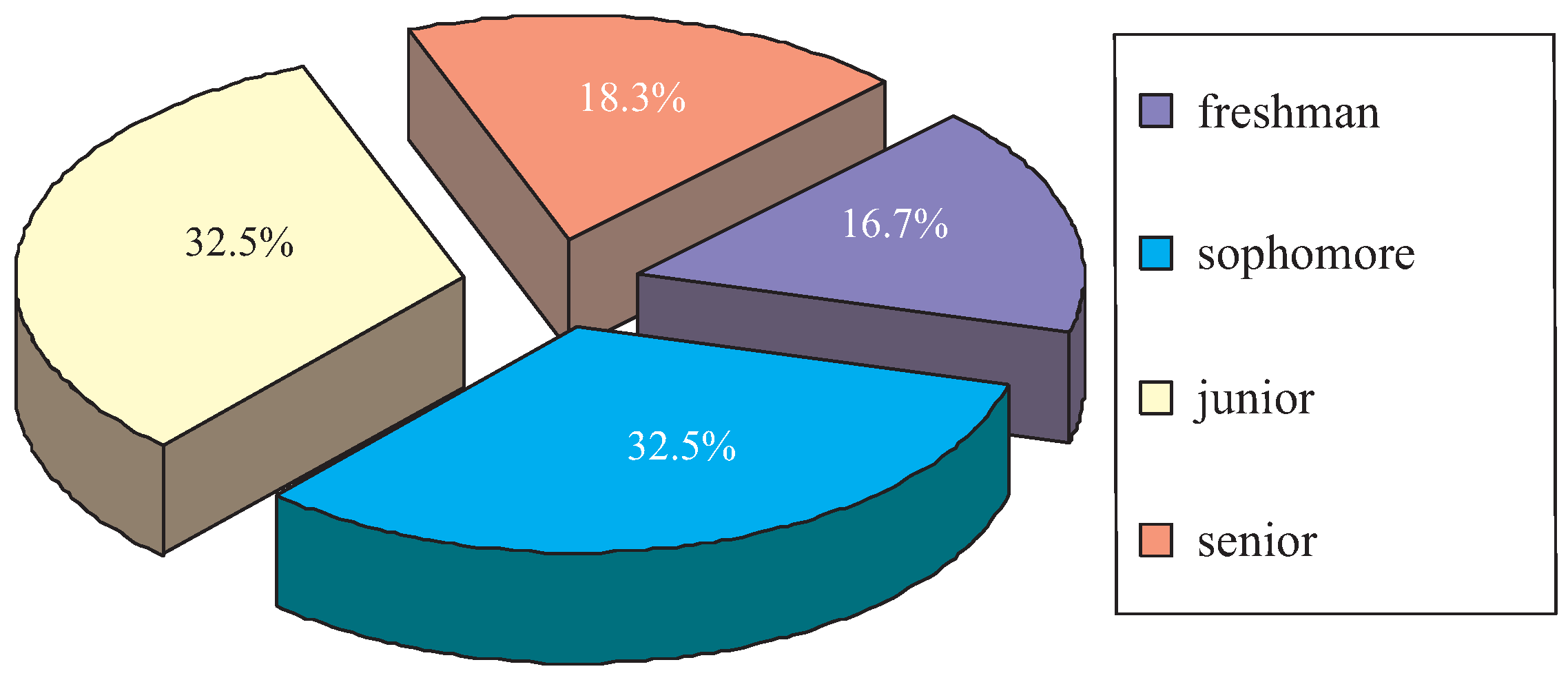
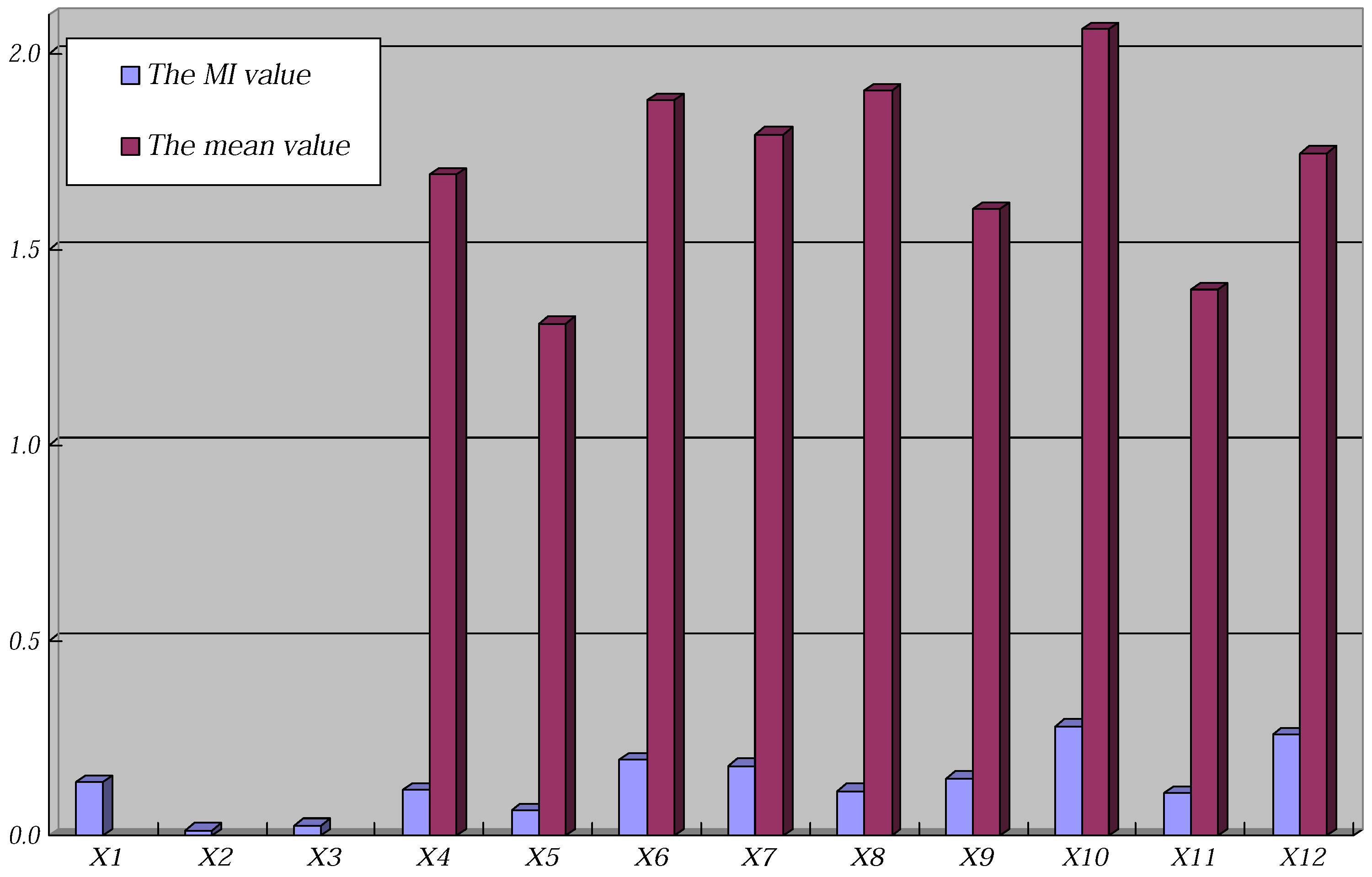
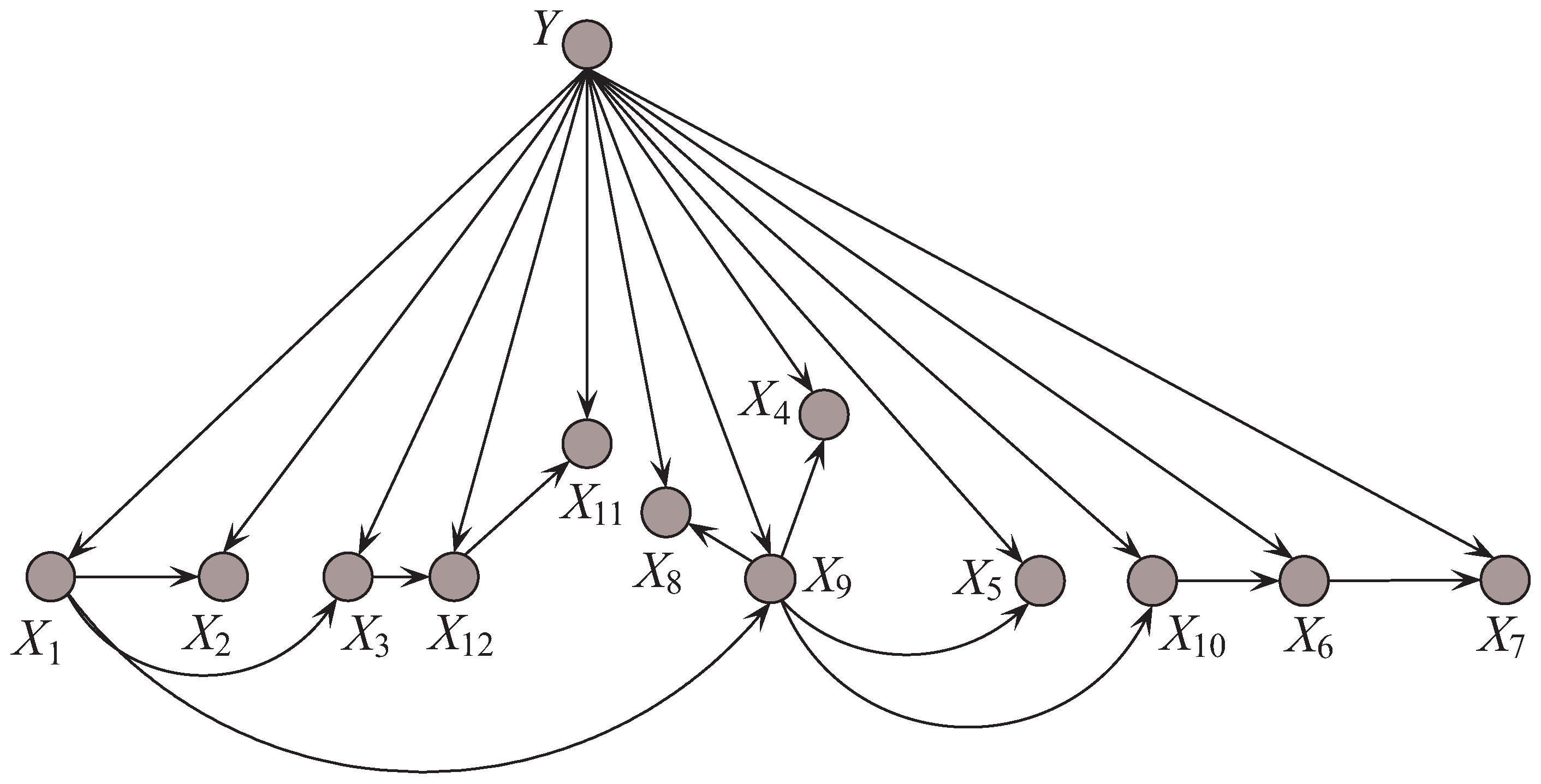
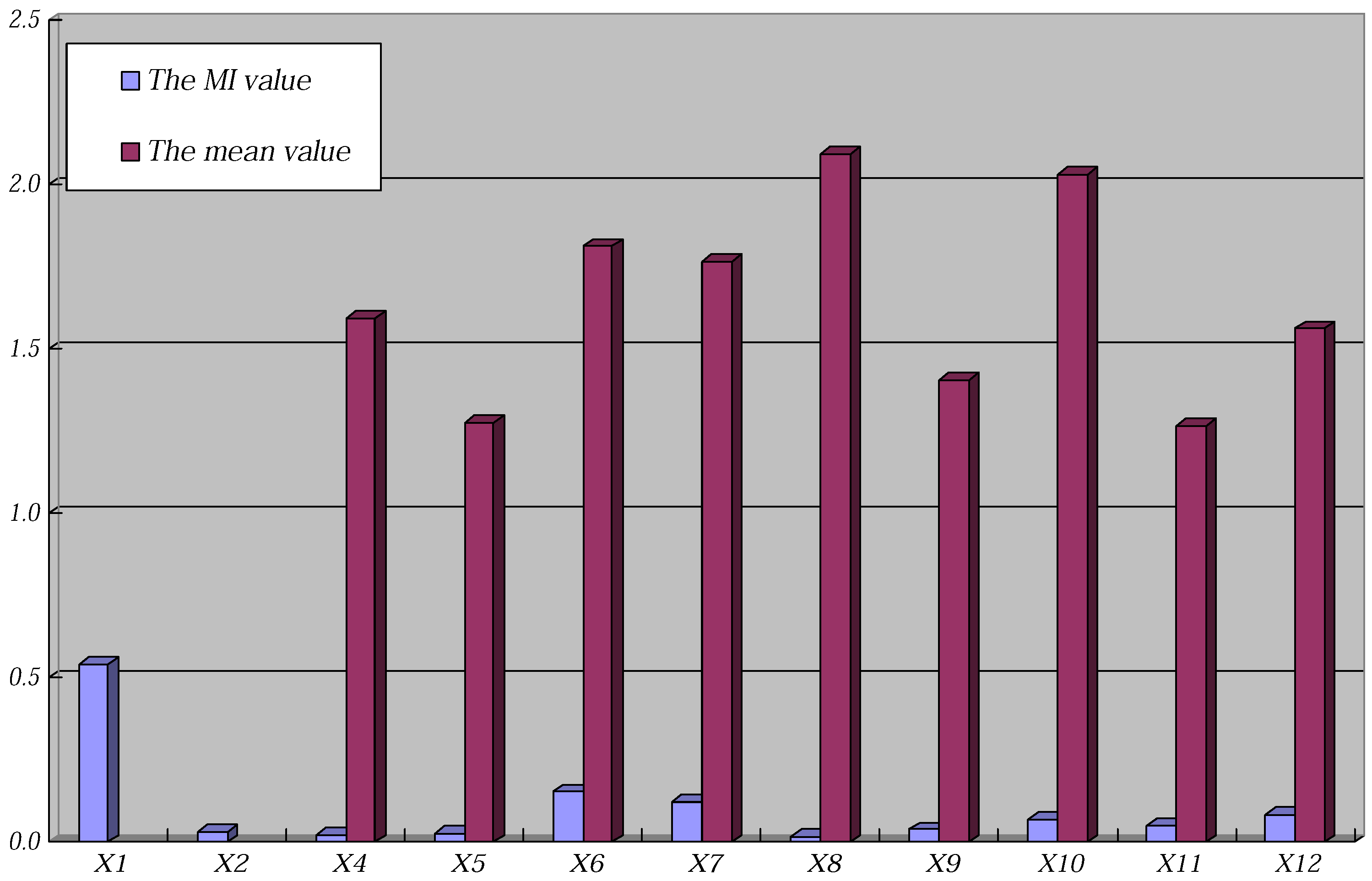
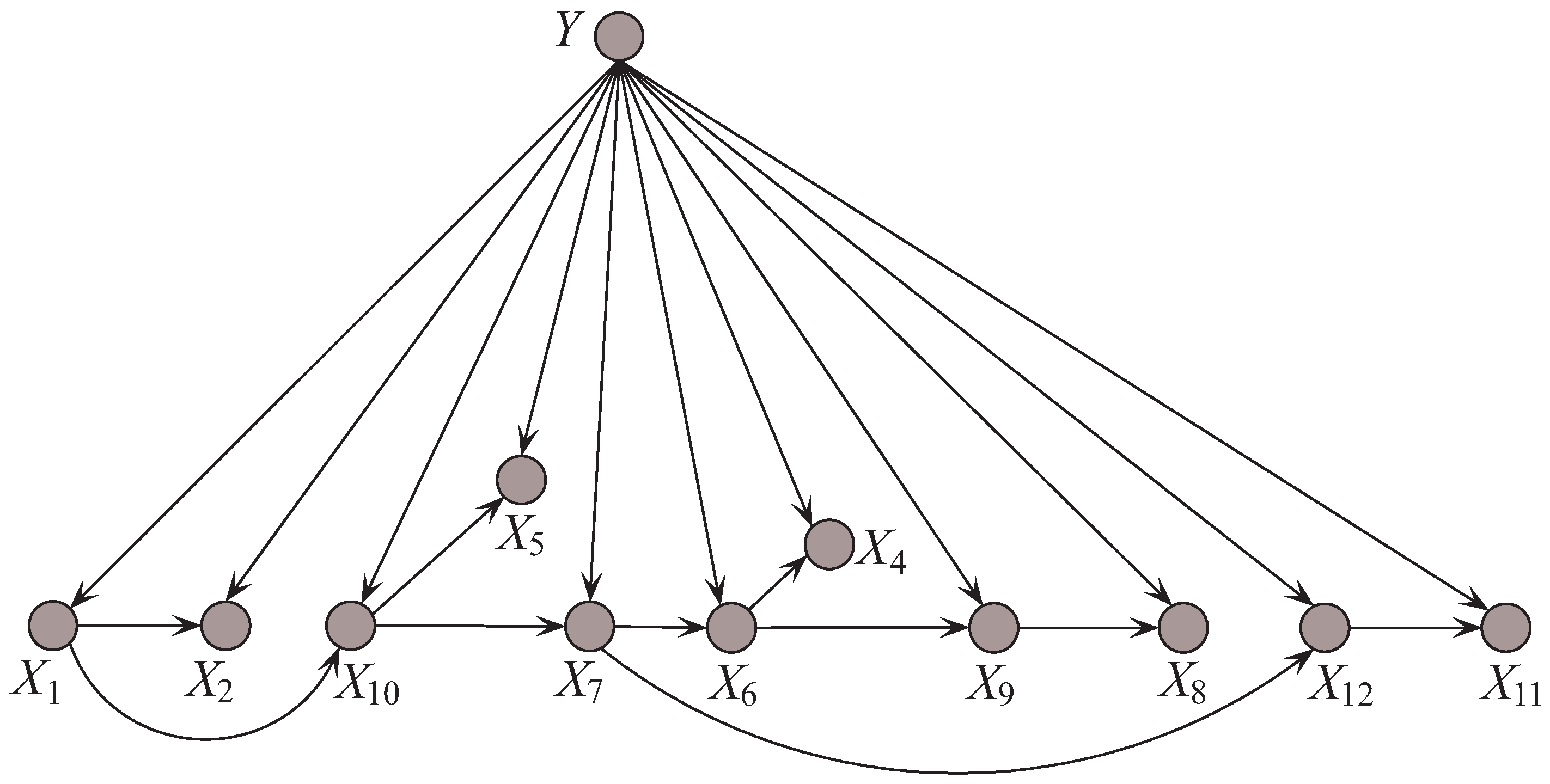
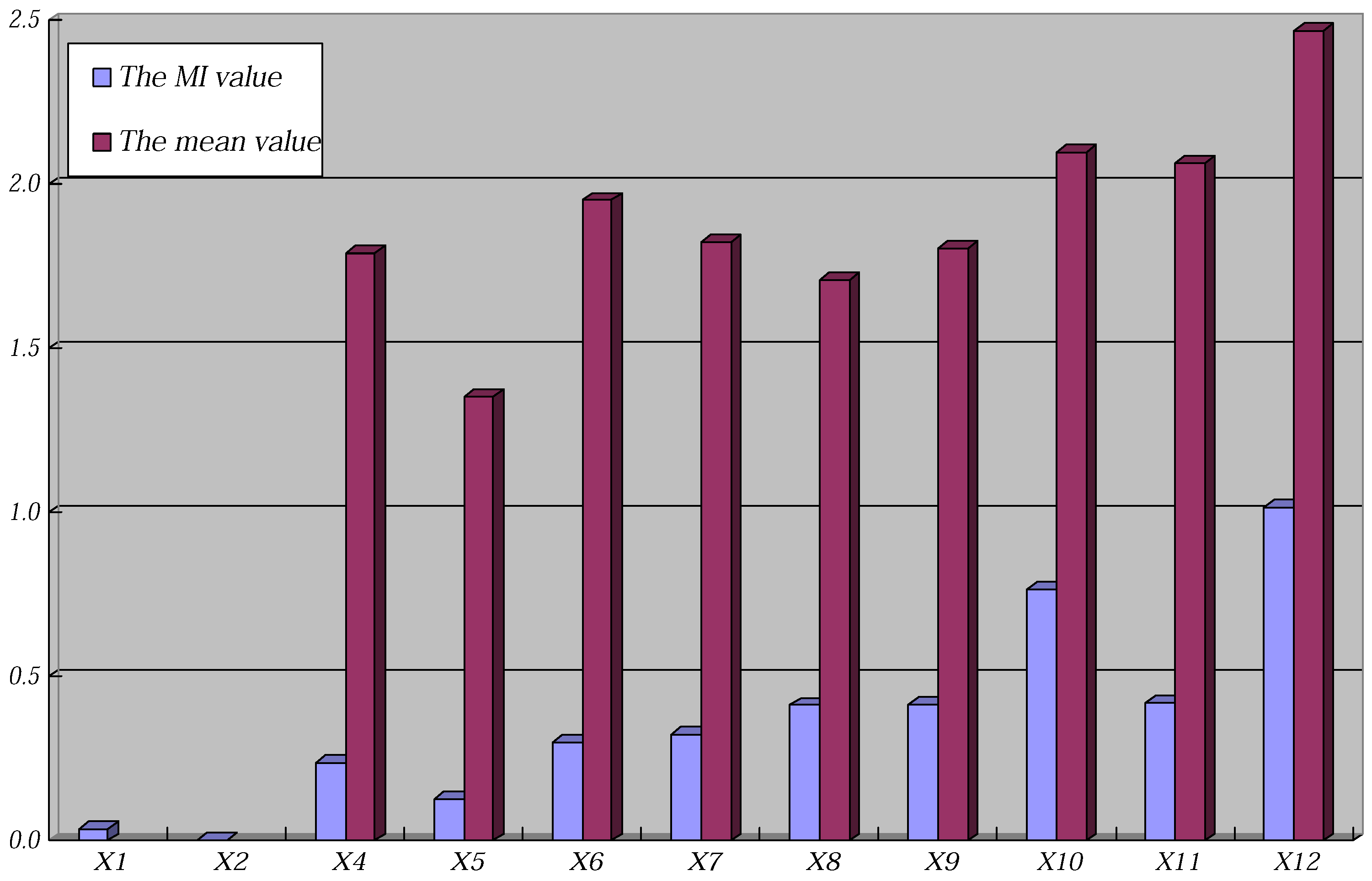

| No | Items | Possible Answers | Symbol |
|---|---|---|---|
| Q1 | Grade | {1, 2, 3, 4} | |
| Q2 | Gender | {Male, Female} | |
| Q3 | Major | {Liberal Arts, Science} | |
| Q4 | Studying English helps improve my personality, or personality for short | {1, 2, 3} | |
| Q5 | Studying English helps maintain good interpersonal relationship, or relationship for short | {1, 2, 3} | |
| Q6 | Studying English helps gain knowledge and understand cultural differences, or knowledge for short | {1, 2, 3} | |
| Q7 | Studying English helps create new thoughts, or thoughts for short | {1, 2, 3} | |
| Q8 | Frankly, I study English just to pass the exams, or exams for short | {1, 2, 3} | |
| Q9 | Studying English is enjoyable, or enjoyment for short | {1, 2, 3} | |
| Q10 | English is important in my life, or importance for short | {1, 2, 3} | |
| Q11 | I plan to work for transnational or foreign corporations, or corporations for short | {1, 2, 3} | |
| Q12 | I plan to apply for Master or PhD degree, or degree for short | {1, 2, 3} | |
| Attitude | {Negative or N, Neutral or O, Positive or P} | Y |
| 0.0000 | ||||||||||||
| 0.0976 | 0.0000 | |||||||||||
| 0.2504 | 0.0088 | 0.0000 | ||||||||||
| 0.1993 | 0.0413 | 0.0785 | 0.0000 | |||||||||
| 0.1008 | 0.0364 | 0.0164 | 0.1282 | 0.0000 | ||||||||
| 0.1535 | 0.0907 | 0.0434 | 0.2486 | 0.1161 | 0.0000 | |||||||
| 0.1670 | 0.0682 | 0.0525 | 0.1640 | 0.1509 | 0.6861 | 0.0000 | ||||||
| 0.1208 | 0.0162 | 0.1489 | 0.2373 | 0.1192 | 0.2305 | 0.2326 | 0.0000 | |||||
| 0.2533 | 0.0351 | 0.1625 | 0.2866 | 0.2426 | 0.2476 | 0.2339 | 0.2905 | 0.0000 | ||||
| 0.1554 | 0.0390 | 0.1567 | 0.1842 | 0.1994 | 0.3770 | 0.3118 | 0.2358 | 0.2930 | 0.0000 | |||
| 0.1600 | 0.0294 | 0.1780 | 0.0809 | 0.0255 | 0.0404 | 0.0534 | 0.1190 | 0.1103 | 0.0726 | 0.0000 | ||
| 0.1772 | 0.0123 | 0.3317 | 0.1529 | 0.0670 | 0.1134 | 0.1987 | 0.1054 | 0.2468 | 0.1852 | 0.4963 | 0.0000 |
| 0.0000 | |||||||||||
| 0.1699 | 0.0000 | ||||||||||
| 0.0528 | 0.0148 | 0.0000 | |||||||||
| 0.0493 | 0.0286 | 0.0675 | 0.0000 | ||||||||
| 0.1564 | 0.0489 | 0.2595 | 0.2178 | 0.0000 | |||||||
| 0.1755 | 0.0536 | 0.2224 | 0.2242 | 0.7620 | 0.0000 | ||||||
| 0.1199 | 0.0341 | 0.1761 | 0.1989 | 0.2807 | 0.3200 | 0.0000 | |||||
| 0.0622 | 0.0256 | 0.1090 | 0.3126 | 0.3641 | 0.2462 | 0.4067 | 0.0000 | ||||
| 0.2663 | 0.0721 | 0.1959 | 0.3656 | 0.4527 | 0.4874 | 0.2907 | 0.2766 | 0.0000 | |||
| 0.0765 | 0.0106 | 0.0082 | 0.0332 | 0.0561 | 0.0840 | 0.0683 | 0.0551 | 0.1262 | 0.0000 | ||
| 0.1298 | 0.0430 | 0.1235 | 0.0794 | 0.1529 | 0.3251 | 0.2204 | 0.2532 | 0.1681 | 0.4829 | 0.0000 |
| 0.0000 | |||||||||||
| 0.1600 | 0.0000 | ||||||||||
| 0.3512 | 0.1449 | 0.0000 | |||||||||
| 0.1681 | 0.0673 | 0.2529 | 0.0000 | ||||||||
| 0.2921 | 0.1826 | 0.3671 | 0.1353 | 0.0000 | |||||||
| 0.2545 | 0.1371 | 0.2065 | 0.1495 | 0.6222 | 0.0000 | ||||||
| 0.1271 | 0.0509 | 0.2512 | 0.1496 | 0.1843 | 0.1918 | 0.0000 | |||||
| 0.3457 | 0.0983 | 0.3967 | 0.2043 | 0.2605 | 0.3561 | 0.3553 | 0.0000 | ||||
| 0.0859 | 0.0360 | 0.1517 | 0.1338 | 0.2635 | 0.1588 | 0.1491 | 0.2858 | 0.0000 | |||
| 0.3099 | 0.0725 | 0.2154 | 0.1394 | 0.0989 | 0.1001 | 0.2586 | 0.2172 | 0.1655 | 0.0000 | ||
| 0.1257 | 0.0519 | 0.1690 | 0.0808 | 0.1179 | 0.1119 | 0.0800 | 0.1142 | 0.1819 | 0.4585 | 0.0000 |
© 2019 by the authors. Licensee MDPI, Basel, Switzerland. This article is an open access article distributed under the terms and conditions of the Creative Commons Attribution (CC BY) license (http://creativecommons.org/licenses/by/4.0/).
Share and Cite
Zuo, X.; Weaver, R.; MacRae, J.; Wang, L. How Much Do Emotional, Behavioral, and Cognitive Factors Actually Impact College Student Attitudes towards English Language Learning? A Quantitative and Qualitative Study. Information 2019, 10, 166. https://doi.org/10.3390/info10050166
Zuo X, Weaver R, MacRae J, Wang L. How Much Do Emotional, Behavioral, and Cognitive Factors Actually Impact College Student Attitudes towards English Language Learning? A Quantitative and Qualitative Study. Information. 2019; 10(5):166. https://doi.org/10.3390/info10050166
Chicago/Turabian StyleZuo, Xin, Regina Weaver, Julia MacRae, and Limin Wang. 2019. "How Much Do Emotional, Behavioral, and Cognitive Factors Actually Impact College Student Attitudes towards English Language Learning? A Quantitative and Qualitative Study" Information 10, no. 5: 166. https://doi.org/10.3390/info10050166
APA StyleZuo, X., Weaver, R., MacRae, J., & Wang, L. (2019). How Much Do Emotional, Behavioral, and Cognitive Factors Actually Impact College Student Attitudes towards English Language Learning? A Quantitative and Qualitative Study. Information, 10(5), 166. https://doi.org/10.3390/info10050166





